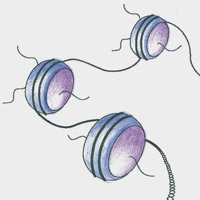Accelerating chromatin mapping with single-cell ATAC-seq
Whether the cost is too high, the throughput is too low, or the sensitivity is inadequate, existing technologies are often unable to investigate our ideas as thoroughly as we'd like. However, these shortcomings drive innovation and spur the development of new tools to overcome these limitations. This philosophy led us to develop our ICELL8 Single-Cell System, an open and flexible platform designed to let you push the boundaries of your single-cell research.
In this installment of the ICELL8 Innovators Series, we highlight the Greenleaf lab at Stanford University. In conjunction with Takara Bio USA, Inc., they developed a simple, high-throughput, workflow for single-cell assay for transposase-accessible chromatin-seq (scATAC-seq) that generates libraries from >1,000 cells in as little as 4–5 hours.
Chromatin accessibility: a sequence of challenges
In addition to its sequence, chromatin structure plays a key role in regulating gene expression. Chromatin remodeling can change the accessibility of DNA to binding proteins and transcription factors, promoting or suppressing gene transcription. However, traditional chromatin mapping techniques have proven challenging due to expensive, low-throughput, and/or high-complexity workflows. These obstacles are magnified by the fact that single cells (even those within the same tissue or cell subtype) may have distinct patterns of chromatin structure that bulk experiments do not always reveal.
A singular protocol: the new approach to map chromatin
To break through these barriers, the Greenleaf lab leveraged our flexible ICELL8 Single-Cell System to develop a high-throughput scATAC-seq protocol (Figure 1). Cells are automatically isolated, dispensed into, and imaged on a blank 5,184-nanowell ICELL8 350v Chip. Wells containing live single cells (assayed by Hoechst and propidium iodide dyes) are automatically identified and selected with our CellSelect Software, saving both time and reagents by only dispensing reagents to selected wells. Transposition, index addition, and PCR amplification (Figure 1, Panels 2–5) are performed on-chip, minimizing technical variability and hands-on time. The PCR amplicons are pooled off-chip, purified with size-selection beads, and are then ready for your sequencing workflow.

Figure 1. Schematic of the ATAC-Seq workflow on the ICELL8 Single-Cell System. Cells are automatically dispensed, imaged, and live single-cell wells are selected (Panel 1). A transposition mix containing Tn5 transposase is added to selected wells and subjected to thermal cycling (Panel 2). Index 1 is added in a high-EDTA mix to remove bound transposase, followed by the addition of index 2 in a high-MgCl2 mix to quench the EDTA (Panels 3–4). Selected wells are then subjected to on-chip PCR amplification (Panel 5). Figure by Anja Mezger et. al., used under CC BY 4.0.
It pays to innovate: chromatin profiles reveal distinct cell types
Peripheral blood mononuclear cells (PBMCs) are a functionally diverse group of blood cells consisting of monocytes, B cells, and T cells. Following blood draws from three separate donors, the Greenleaf lab used their scATAC-seq protocol to assess the chromatin profiles of single PBMCs. Strikingly, chromatin accessibility patterns within transcription factor start sites revealed the distinct grouping of cells into monocyte, B-, and T-cell clusters (Figure 2), indicating the utility of this protocol for de novo clustering of cell types within complex samples.

Figure 2. scATAC-seq of PBMCs reveals robust clustering of cell type based upon chromatin accessibility patterns. Chromatin accessibility for all cells (Panel A), PU.1 (Panel B), C/EBPα (Panel C), and RUNX1 (Panel D) demonstrates discrete clusters of monocytes and B and T cells. Figure by Anja Mezger et. al., used under CC BY 4.0.
ICELL8ing innovation: who's next?
Our ICELL8 Single-Cell System provides an open, flexible platform to develop and optimize your assay. In this installment of the ICELL8 Innovators Series, we provided a look at how the Greenleaf lab at Stanford University leveraged these features to develop a rapid, high-throughput scATAC-seq protocol, while the seminal article gave a glimpse at how other researchers used our ICELL8 system to develop a novel single-cell CUT&Tag technology. There are more innovators to come, so fill out the form below to be the first to know when we release additional ICELL8 Innovators Series articles and learn more about how we can make your research better, faster.
References
Mezger, A. et al. High-throughput chromatin accessibility profiling at single-cell resolution. Nat. Commun. 9, 3647 (2018).
Takara Bio USA, Inc.
United States/Canada: +1.800.662.2566 • Asia Pacific: +1.650.919.7300 • Europe: +33.(0)1.3904.6880 • Japan: +81.(0)77.565.6999
FOR RESEARCH USE ONLY. NOT FOR USE IN DIAGNOSTIC PROCEDURES. © 2025 Takara Bio Inc. All Rights Reserved. All trademarks are the property of Takara Bio Inc. or its affiliate(s) in the U.S. and/or other countries or their respective owners. Certain trademarks may not be registered in all jurisdictions. Additional product, intellectual property, and restricted use information is available at takarabio.com.




